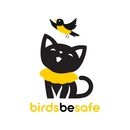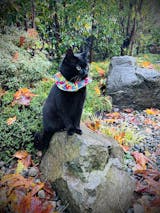News from the Australian Field Study of Birdsbesafe® Covers
At Murdoch University in Perth, Australia, a team led by PhD-student Catherine Hall conducted a lengthy and large field study of Birdsbesafe devices and their effects on native fauna (including birds and lizards). You can find the study in full, here, in the Journal of Applied Animal Behaviour.
The journal article is titled: Assessing the effectiveness of the Birdsbesafe® anti-predation collar cover in reducing predation on wildlife by pet cats in Western Australia.
It's important to keep in mind that in Western Australia, one finds birds, lizards and other fauna that are significantly different from the U.S. regions where Birdsbesafe has been developed and its design perfected. Birdsbesafe uses bright colors to warn local birds and help them notice the hunting cat in time to avoid being captured. Its bright colors are readily seen by songbirds with special color vision ability. Songbirds have a fourth cone, specialized for seeing bright colors. Now, onto the study:
1. A field study involving cats in and around Perth tested whether or not Birdsbesafe wearing cats caught fewer birds and if any predation on any other fauna were affected. Cats and other creatures with specialized color vision ability (such as lizards) saw their capture rates reduced by 47 - 54% over the two different trial periods (spring 2013 and spring 2014).
2. There were differences among the different patterns of Birdsbesafe fabrics. They tested a red print and a yellow flowered print, neither of which we sell any more, and they tested our "Organic Stripes" pattern: Shown at left. This pattern seemed most effective at protecting birds in Australia.
There were differences among the different patterns of Birdsbesafe fabrics. They tested a red print and a yellow flowered print, neither of which we sell any more, and they tested our "Organic Stripes" pattern: Shown at left. This pattern seemed most effective at protecting birds in Australia.
3. A unique discovery of their research is that the bright-colored fabric collar covers protected herpetofauna (lizards) rather well. This was a new finding, and is leading to some excitement as many lizards are vulnerable species in the region, and it is noted that they have good colour vision, and there has heretofore not been a known way to protect them from cats, either domestic or feral.
4. Customer satisfaction was terrific. Cat owners felt that the device was accepted by their cats "Overall, 77% of cat owners planned to continue using Birdsbesafe after the study." Ease of use and cat acceptance was validated, with 79% of owners saying that their "cats had no problem with it".
Reduction in Capture Rates of Birds: Why the differences between the U.S. and Australian studies in the rates they report--about 50% in Australia and 87% in the U.S.? Here's our analysis, and it's as objective as we know how to be. As the company who makes Birdsbesafe products, we have tailored our fabric color and pattern selection to those fabrics that work best for our customers. Customers' cats are our de facto "field testers" and every time someone reveals color and pattern information, we note it and adjust accordingly.
So... in the Western Australian research report, you can read that many of the birds captured by cats wearing our device were "honey-eaters" and also, some species of doves: all of which are NOT songbirds. So their color vision is likely different than the songbirds that have the fourth cone specialized for color vision.
And, in the case of honey-eaters, those birds (of which we have none in North America) are attracted to flowers, and, I think, to the fuschia color in the pattern of fabric that they tested. Going forward, in Australia, I will hope that other patterns and colors will be tested and that more understanding will be gained about the local susceptible bird species and their color vision.
In the North American, and European contexts, however, it seems that our product is now protecting songbirds at the reported 87% reduction rate. We've worked super hard to elicit the "formula" of which colors and patterns work best.
To be continued... As I always say, nature is complex, but we are onto something here that is helping birds very much!
All in all, the Australian team conducted a great field study effort. The journal article is lengthy and we hope you enjoy reading it! A hearty thanks to the hard-working and kind Australians who studied our product in the land down under. We hope it will be making a difference in cat predation on local birds AND lizards more and more, as time goes on!














